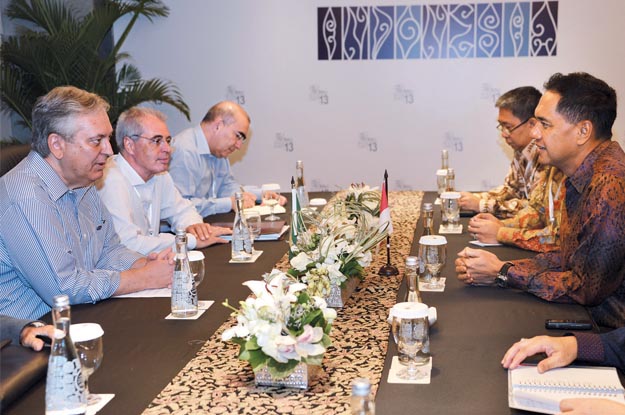With growth in Latin America expected to decline for a fifth consecutive year in 2015, trade can be a powerful engine for economic renewal. However, it’s clear to most observers that at present this engine is not firing on all cylinders.
The World Trade Organization (WTO) forecasts a rise of just 0.2 percent in the value of merchandise exports among South and Central American countries this year, following a 2.5 percent decline in 2014—the poorest global performance last year. While there are a number of factors behind these gloomy figures, trade can play a crucial role in improving the region’s economic outlook.
New agreements, for example, on trade in agricultural produce, industrial goods and services could lower barriers to doing business across borders and sharply reduce long-standing distortions in the trading system. These issues are currently on the table at the wto as part of the Doha Development Agenda—otherwise known as the Doha Round. The wto’s upcoming Ministerial Conference in Nairobi in December—the fi rst such wto meeting in Africa—should help to focus minds and test whether we have the political will necessary to make progress.
The region’s lackluster performance in recent years is partially due to broader macroeconomic trends. The unbalanced global recovery has, in the near term at least, created economic uncertainty in the region. Slower growth in China could mean that commodity prices continue to weaken, undermining prospects for the region’s major food and fuel exporters. Economic conditions in the European Union, which accounts for a third of world trade, are improving but are still fragile. A recovery in the U.S. will remain crucial, and some raise concerns about the broader impact on global economic growth of any hike in U.S. interest rates. In addition, the IMF points to increasing financial risks in Latin America following a long period of strong capital inflows.
These major trends are clearly difficult to counteract. Since the global financial crisis, governments and central banks in the world’s major economies have used nearly every tool at their command in an effort to generate a recovery. Their strategy has included cutting interest rates to historic lows and pursuing unorthodox policies such as quantitative easing. But one policy tool that governments have yet to fully utilize is trade as a stimulus for demand.
We can take encouragement from important advances in other areas in recent years. In December 2013, for example, WTO members struck a historic deal in Bali. Among the decisions taken in Bali was the Trade Facilitation Agreement, which will help reduce border bottlenecks and modernize customs procedures in member countries. This agreement could deliver an economic boost of up to $1 trillion annually, with most of the gains going to developing countries. Bali also delivered a series of plans to integrate least-developed countries (LDCs) into the global economy. The WTO is working to bring this agreement into force and deliver these benefits; and it will require member states to complete their domestic ratification processes.
Considering the huge potential benefits for growth and development, widening the international trading community is a real priority.
Bali was an important step forward, but now we need to deliver more through the Doha Round. Elsewhere in the WTO, work is under way to agree on an expansion of duty-free benefits on a range of high-tech exports and to liberalize trade in environmental goods, such as wind turbines and solar panels. These initiatives would deliver significant economic gains.
Besides our work at the WTO, there are ongoing efforts to liberalize trade at both the bilateral and regional level. To date, more than 250 agreements have entered into force, according to notifications received by the WTO. Latin American countries are deeply involved in these efforts, whether they are taking place within the region or outside. Some countries in the region are engaged in talks on the Trans-Pacific Partnership (TPP), for example, which has been in the headlines recently. Negotiations at the WTO can work in perfect harmony with other trade negotiations such as the TPP because, ultimately, they are all pushing in the same direction.
However, some concerns have been raised. For example, bilateral and regional trade agreements can tend to exclude the smallest and most vulnerable countries. Also, they may create different sets of rules and regulations that may ultimately increase the regulatory burden. Therefore, we need to ensure that initiatives on each of the different tracks continue to complement and reinforce one another.
While all kinds of trade agreements are welcome, many big issues can only be tackled efficiently in the multilateral context. Agricultural subsidies are one example. Because of their global nature, trade-distorting farm subsidies cannot be addressed even through megaregional trade agreements.
In addition, rather than simply deepening existing trade connections, multilateral reforms allow new trading relationships to be established. The fact is, global deals deliver far more than any other approach.
Trade can be a powerful engine to support both growth and development in Latin America and around the world. It allows countries to benefit from economic growth elsewhere, as well as from new inflows of capital, new technologies, new innovations, and a wider range of goods for consumers and firms to use. It means increasing the exchange of goods, ideas, resources, and capabilities—all of which support economic growth. Moreover, trade lowers the prices of consumer and industrial goods, which can in turn stimulate demand and increase productivity.
This is the perfect moment to put trade to work as a driver of growth.
But it cannot be achieved without a strong, vibrant global trading system. Therefore, we must redouble engagement at the global level, through the WTO. Now is the time to act.



